Still stuck auditing 2% of your calls? You’re not alone.
Call center quality management hasn’t changed much in the last decade.
Most teams still rely on manual audits—listening to a handful of random calls and hoping they represent the whole picture.
Spoiler alert: they don’t.
According to McKinsey, less than 5% of customer interactions are actually reviewed by quality teams.
That means 95% of agent behavior goes unchecked—including missed sales cues, compliance slip-ups, and tone issues.
Now imagine this:
- Automated call auditing
- Getting insights in minutes
- Coaching agents based on data, not gut feeling
Sounds like a dream? That’s exactly what Automated Quality Management (AQM) promises.
In this article, we’ll break down what AQM really is, how it works, and how it can totally flip your QA process for the better—without flipping your budget.
Table of Contents
A. What Is Automated Quality Management (AQM)?
Manual QA is like using a flip phone in the iPhone era.
You randomly pick a few calls, listen in, take notes, fill out a form—and still miss 90% of what matters.
Automated Quality Management (AQM) is the smarter, faster way to monitor calls. It uses AI and speech analytics to listen to every call, flag issues, and even score agents automatically.
Here’s what it typically does:
- Transcribes calls (and chats) accurately
- Identifies keywords, tone shifts, silence, and interruptions
- Flags compliance breaches and soft skill misses
- Scores each interaction based on your QA framework
- Delivers insights straight to your dashboard—no manual effort needed
Time spent on audits? Down by 70 percent. Call coverage? 100 percent. Yes, every single call.
Think of it as your QA team’s new superpower—scanning thousands of calls in minutes and handing you exactly what needs fixing.
No more guesswork. No more cherry-picking.
Just clean, consistent, and complete insights on how your agents really sound.
B. Manual vs. automated QA: What’s the real difference?
Manual QA might have worked when your team handled a few hundred calls a week.
But today, when you’re dealing with thousands of conversations across voice and chat, it’s just not built to keep up.
That’s where Automated Quality Management steps in.
It doesn’t replace your QA team—it makes them 10x more efficient.
Here’s how the two approaches stack up:
| Criteria | Manual QA | Automated QA |
| Call Coverage | 2–3% of calls | 100% of calls |
| Time per Evaluation | 15–30 minutes | Under 2 minutes |
| Feedback Consistency | Depends on reviewer | Standardized across all interactions |
| Compliance Checks | Misses common violations | Flags every risk based on set rules |
| Scalability | Needs more QA headcount | Scales without extra hires |
| Coaching Insights | Based on limited data | Data-rich, across reps and teams |
| Bias & Subjectivity | High—depends on who’s listening | Low—rules-based and repeatable |
| ROI | Hard to justify with low coverage | Higher impact with full visibility |
Manual reviews give you guesses. Automated QA gives you proof—at scale.
C. How AQM audit 100% of calls without burning you out?
AQM isn’t just another tool—it’s a full-on system that listens, evaluates, scores, and flags calls faster than any human team ever could.
Here’s how it works from start to finish:
1. Every call is automatically captured
As soon as a call, chat, or email ends, AQM automatically captures the interaction—no need for manual uploading or tagging.
It connects directly with your contact center tools, ensuring every customer conversation is logged.
You get complete coverage across all channels, without lifting a finger, eliminating the risk of missed or lost interactions.
Enthu.AI easily integrates with the leading telephony, and CRMs.
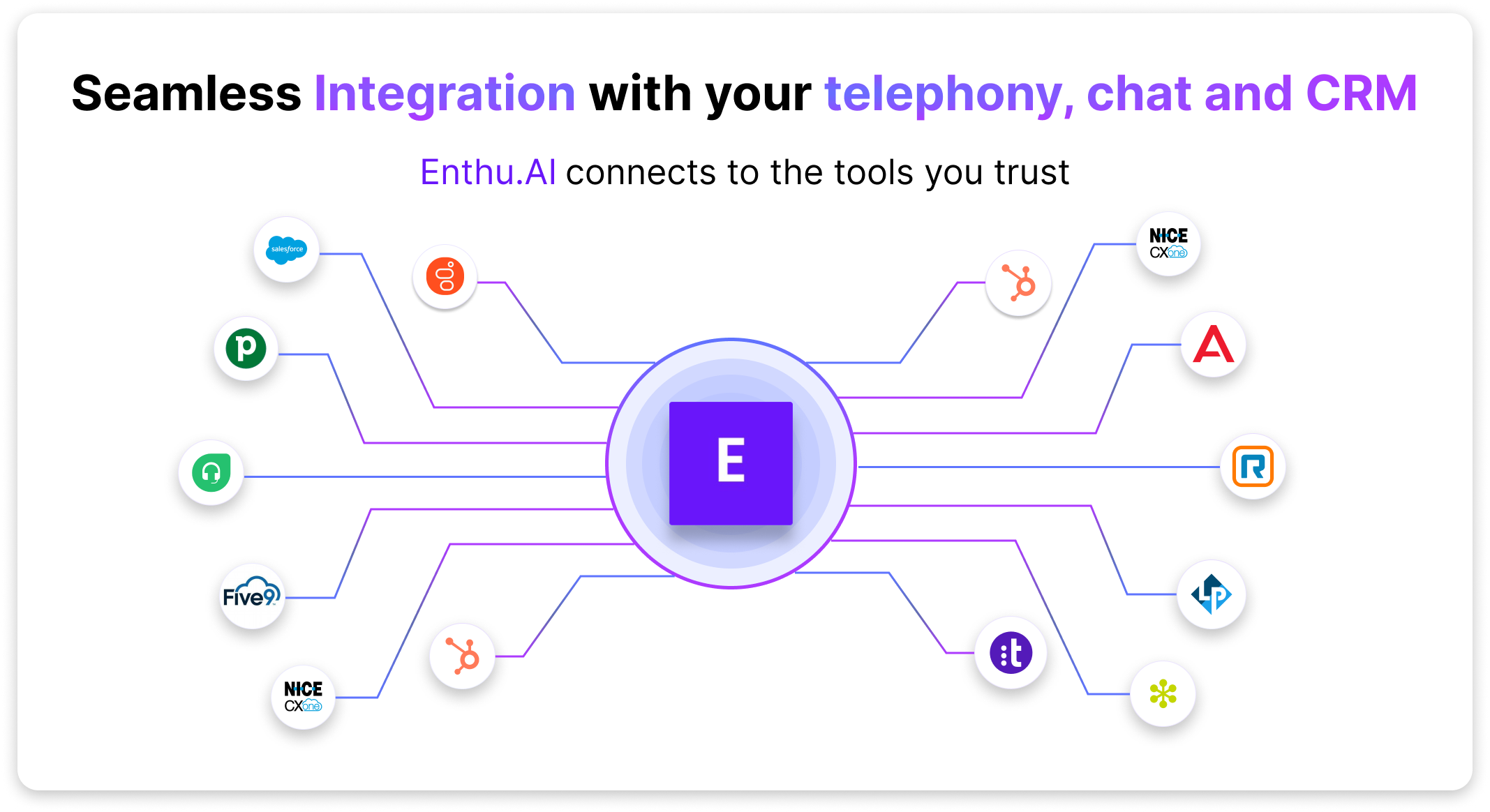
2. Calls are transcribed using speech-to-text
Once captured, voice calls are instantly transcribed using advanced speech-to-text technology.
This turns every spoken word into a detailed text record.
These transcripts are accurate, timestamped, and searchable—making it easy to analyze conversations at scale.
It replaces hours of manual listening with clear, readable conversations ready for automated QA analysis.
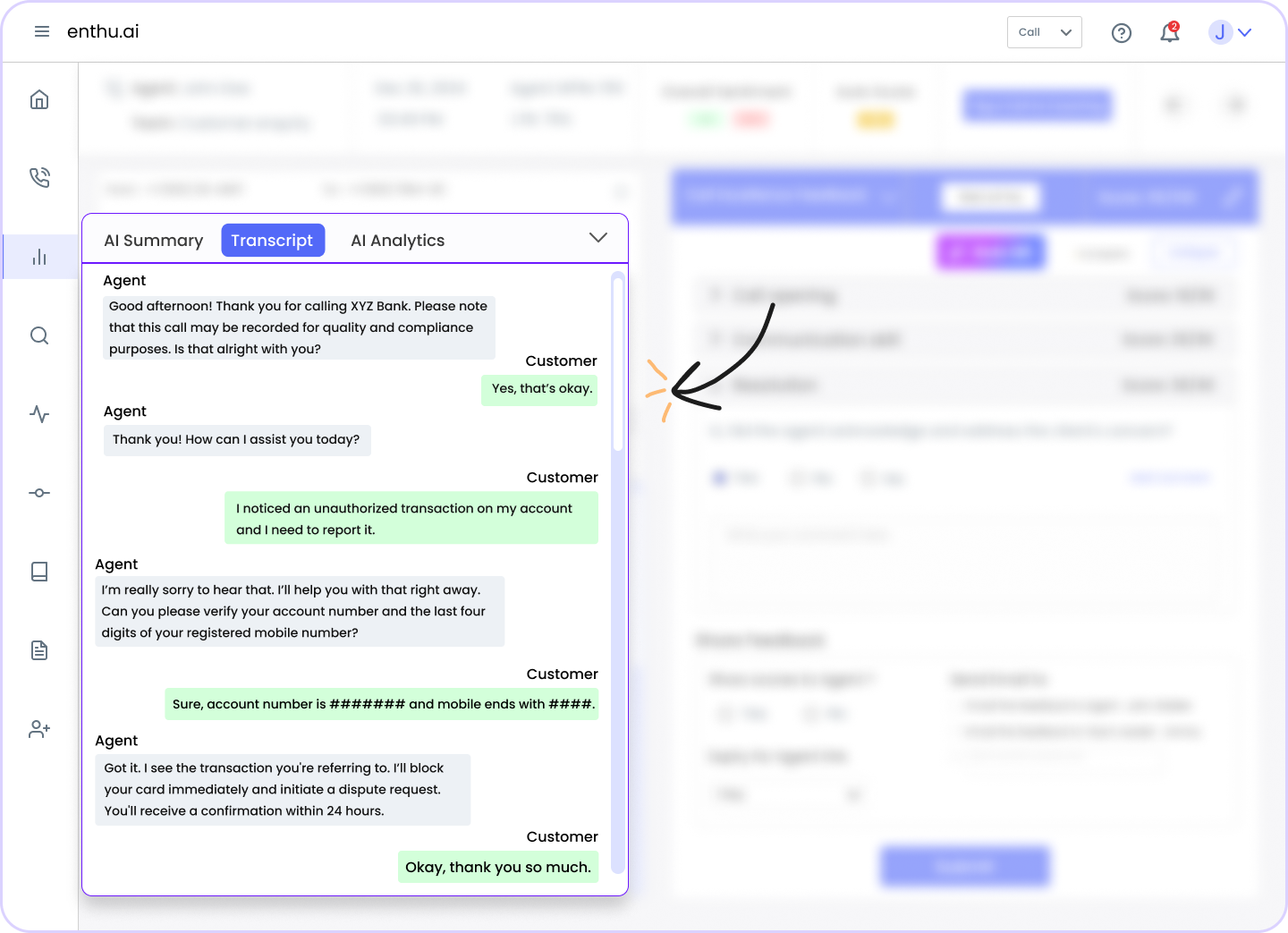
3. AI + NLP analyze the conversation
Natural Language Processing (NLP) and AI dig into the full transcript.
They detect keywords, sentiment shifts, tone of voice, long pauses, crosstalk, and even compliance language.
It’s like having a smart assistant that reviews the conversation for both context and quality—flagging things humans might miss and evaluating the emotional tone behind the words.
4. QA Scorecards are auto-applied
AQM uses your existing QA form—greeting, empathy, product knowledge, compliance checks, and more—and scores every call against it.
This eliminates bias and ensures consistency across evaluations.
Every agent gets scored on every conversation using the same standard, giving you a clear, fair picture of performance across the board.
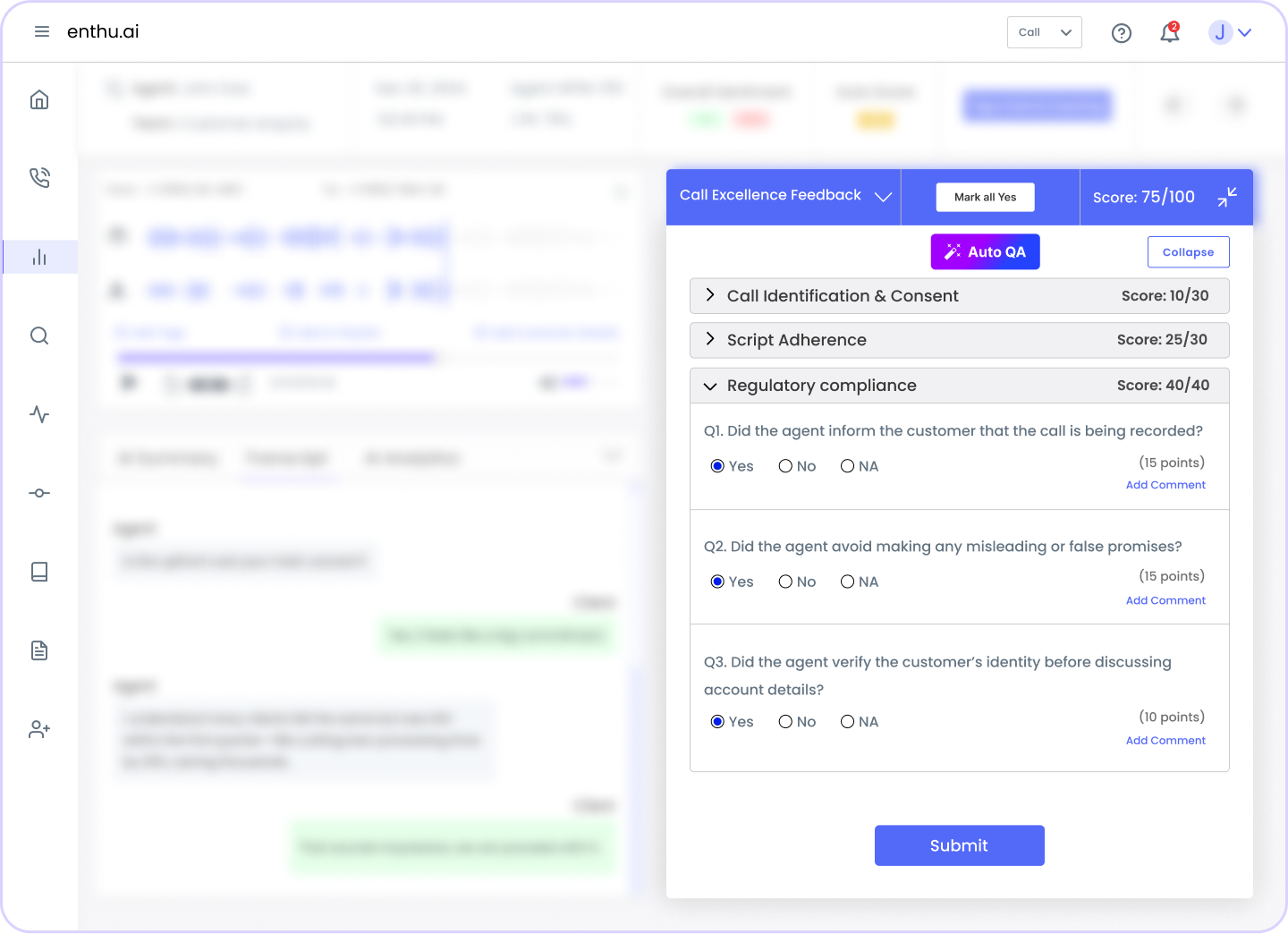
5. Violations and insights are flagged
The system automatically flags calls that violate policies or underperform, like missed disclaimers, negative sentiment, or talkovers.
This allows QA teams to focus only on the interactions that need attention.
Instead of random sampling, you review what truly matters, cutting review time drastically while boosting coaching accuracy.
Enthu.AI marks such calls as zero tolerance.
6. Dashboards turn scores into actionable insights
All QA results are compiled into a clean, interactive dashboard.
You can view performance trends over time, track issues by agent or team, and spot coaching opportunities instantly.
This gives you a real-time pulse on call quality, without spreadsheets or digging through recordings.
You see what’s working—and what’s not—at a glance.
D. Top 5 QA metrics you can automatically track
With AQM, you’re not just tracking if the agent said something—you’re tracking how they said it, when they said it, and what they missed.
Here’s what a solid AQM setup can monitor for you 24/7:
1. Dead air time
AQM calculates how much silence exists during a call—both from the agent and the customer.
Excessive dead air usually signals confusion, lack of knowledge, or system lag.
Tracking this helps you identify when agents struggle to handle a query smoothly and where process gaps may exist.
2. Compliance misses
Did the agent skip the mandatory disclosure? Forget the identity verification?
AQM automatically flags calls where required statements (like legal disclaimers or data privacy notices) are missing or incomplete—saving you from major compliance risks and regulatory headaches.
3. Empathy & tone detection
NLP-based tools can assess tone, language, and sentiment to score how empathetic an agent was during the call.
If an agent sounds robotic or dismissive, it’ll show up.
These metrics help coach agents on emotional intelligence—key to delivering great customer experiences.
4. Script adherence
Automated QA checks whether agents followed the approved call flow or deviated from the script.
This includes whether they used the right greetings, transitions, and closing lines.
It ensures consistency in CX and helps enforce standard communication across the team.
5. Talk-to-listen ratio
This metric reveals how much an agent talks vs. how much they let the customer speak.
High talk-time may indicate poor listening skills or over-explaining.
AQM tracks this automatically, helping you coach for better engagement and customer understanding.
These metrics aren’t just for scoring—they help you pinpoint exactly what to coach and who needs it. No guesswork. Just straight-up, actionable QA data.
E. What are the benefits of AQM?
There’s a reason more quality managers are shifting to Automated Quality Management.
With customer expectations rising and compliance pressure mounting, there’s no room for guesswork or delays.
AQM gives you a direct line into every customer interaction—analyzing conversations, scoring performance, and flagging issues in near real-time.
It’s not just about saving time—it’s about getting sharper insights, faster feedback loops, and coaching that actually sticks.
Here’s how AQM puts you back in control of quality.
1. Every single interaction gets reviewed
AQM evaluates 100% of your customer conversations—voice, chat, and email—on a daily basis.
This kind of insight is similar to how procurement analytics helps identify spending patterns and supplier performance across organizations.
It’s not just about quantity; it’s about understanding what’s really happening on the floor so you can make faster, more confident decisions and reduce blind spots across your QA program.
Enthu.AI surfaces key moments from every conversation, QA leaders don’t need to dig through hours of call recordings—they get the story upfront and can act faster.
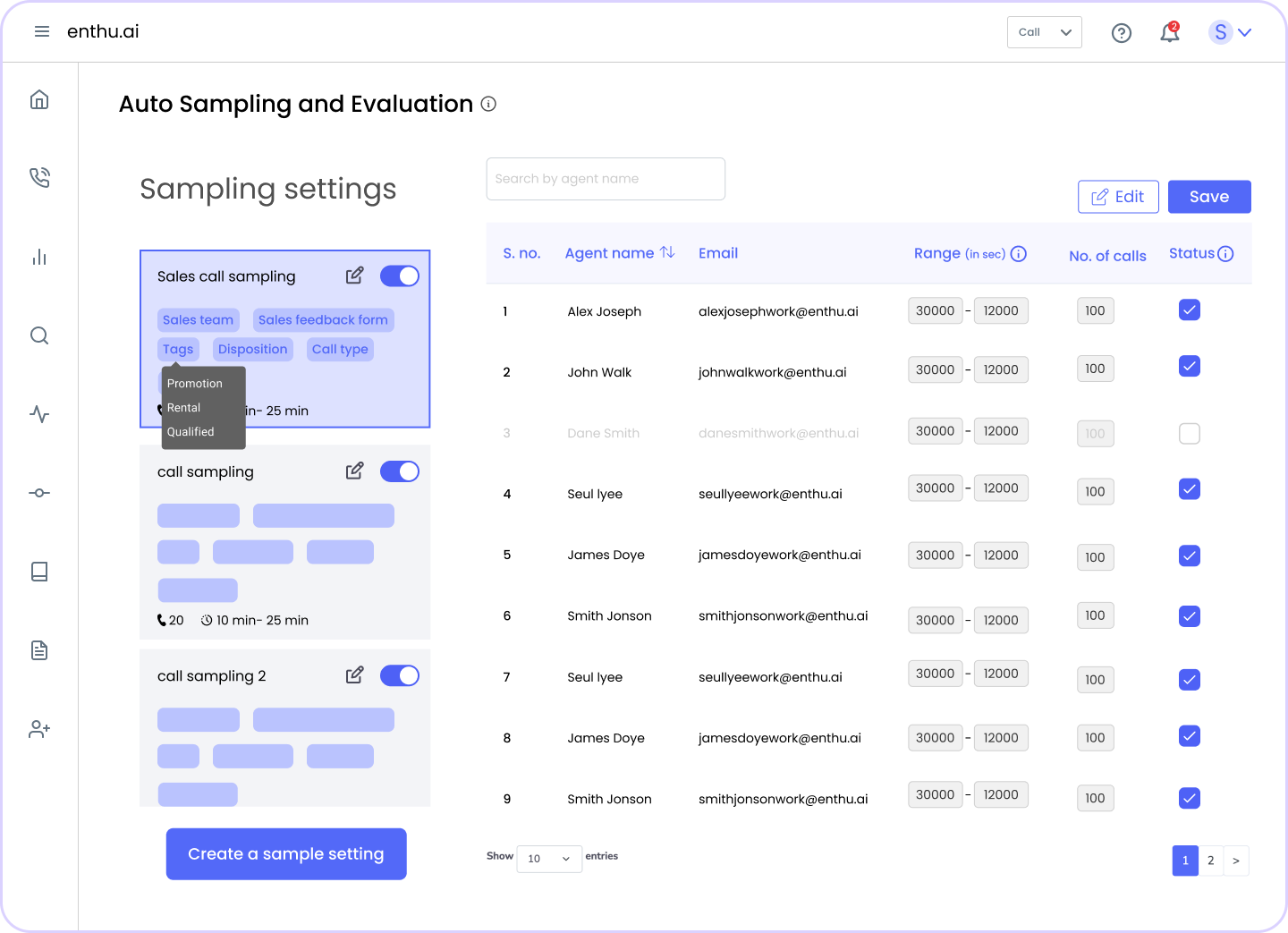
2. QA feedback reaches agents faster
With Auto QA, calls are analyzed and scored minutes after they end.
This means agents get feedback while the conversation is still fresh in their mind, making it easier to absorb and act on.
The faster your reps learn from their mistakes—or double down on what’s working—the faster you’ll see performance improvements across the board.
Feedback becomes part of their daily rhythm, not a monthly report.
3. Scores are consistent and aligned to your standards
AQM follows your custom scorecards to the letter, ensuring each interaction is judged by the same criteria—every time.
That means no inconsistencies, no human interpretation errors, and no performance data you can’t trust.
Whether it’s tone, empathy, script adherence, or talk-to-listen ratio, everything is measured with machine-level precision—making your QA insights clean, consistent, and truly scalable.
4. Coaching becomes targeted and data-led
AQM pinpoints exactly where each agent struggles—be it closing, tone, or missed objections—and backs it up with hard data.
You no longer have to guess where to coach.
Instead, you walk in with specific examples and context for each rep.
This level of personalization boosts coaching effectiveness, accelerates skill development, and makes your 1:1s more impactful, helping agents grow without guesswork.
With Enthu.AI you can tag conversations based on coaching themes, so team leads can go straight to the right clips during 1:1s.
The result? Coaching that’s focused, efficient, and easy to scale.
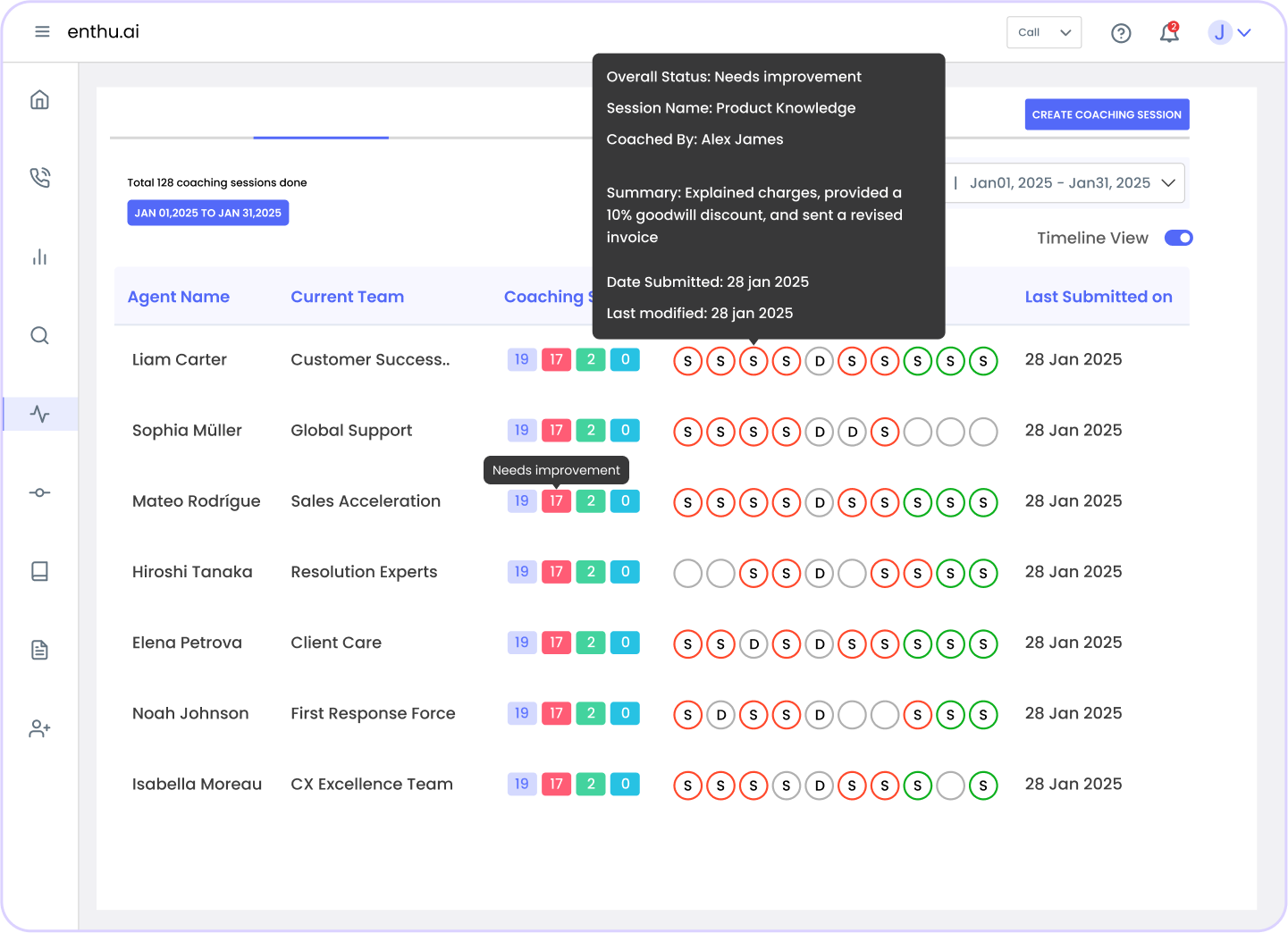
5. Compliance risks are flagged instantly
With AQM, every interaction is checked against your compliance rules automatically—disclosures, disclaimers, consent, verification steps, and more.
If something is missed, the system flags it immediately.
This means fewer violations, fewer escalations, and tighter control over regulatory risks.
You stay prepared for audits and avoid hefty penalties, all while making sure your team plays by the book—on every single call.
6. QA productivity grows without hiring more analysts
AQM operates around the clock—analyzing, tagging, scoring, and surfacing key insights—without the need for manual intervention.
Your QA team no longer spends hours sampling calls or filling out forms. Instead, they focus on what actually drives impact: fixing issues, coaching agents, and improving processes.
You get more value from your existing team and avoid scaling your QA headcount just to keep up.
7. High performers get the recognition they deserve
Automated quality management brings clarity to performance tracking.
It highlights agents who consistently hit the mark—whether it’s first-call resolution, or handling objections.
This helps team leads identify top performers early, reward them meaningfully, and use their call examples for peer learning.
Recognition becomes data-backed, morale improves, and you create a culture where doing the right thing gets noticed—and repeated.
F. How to choose the right AQM tool for your call center
Not every AQM tool fits every call center.
You need one that works for your team, not against it.
Start with scorecards. Can you customize them easily?
Can you track what actually matters—like empathy, pitch accuracy, or compliance?
Look at the dashboard next. It should be simple, visual, and easy to read.
No data scientist required. Platforms like Enthu.AI let you spot trends fast and coach agents in the same place.
Integrations are a must. Your AQM tool should connect with your CRM, dialer, or helpdesk.
No more switching tabs or losing context.
Search is another big one.
You should be able to find calls based on agent name, call type, or issue in seconds. Some tools even let you filter by dead air or missed greetings.
If you handle chat or email, don’t pick a voice-only tool. Go for something that supports all channels in one view.
Lastly, don’t overlook security. Choose a vendor that’s SOC 2 compliant, GDPR-ready, and encrypts everything.
Key Takeaways
- Look for custom scorecards you can edit anytime.
- Choose visual dashboards that highlight insights fast.
- Ensure deep integrations with tools you already use.
- Use tools with advanced search and smart filters.
- Alerts help you catch issues early—set them once and relax.
- Pick platforms that cover voice, chat, and email.
- Security matters—go with encrypted and compliant systems.
Conclusion
Manual QA is like using a candle in a world lit by LEDs—it simply can’t keep up.
With Automated Quality Management, you’re not just saving time; you’re leveling up your entire quality process.
Every call gets heard. Every issue gets flagged. Every agent gets better, faster.
AQM isn’t the future—it’s the now.
If your QA team is still stuck sampling 2% of conversations, it’s time to ask yourself:
What are you missing in the other 98%?
Let Automated Quality Management show you.
FAQs
1. What is Automated Quality Management (AQM)? Automated Quality Management (AQM) is an approach that uses technology and artificial intelligence to streamline and enhance quality assurance processes in call centers. 2. What is the automated QC process? The automated Quality Control (QC) process uses technology and software for real-time data collection, analysis, and immediate feedback. It detects errors, resolves issues, and creates reports to improve quality control accuracy, efficiency, and consistency. 3. What are the 4 types of quality management? The four types of quality management are: These components ensure products and services meet consistent standards and drive ongoing enhancements.



 On this page
On this page


